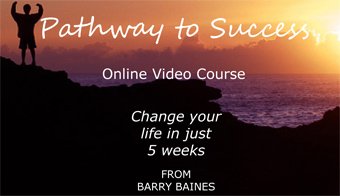How to hypnotise your audience
NLP techniques
Be like the professionals
You can learn how to hypnotise your audience by the use of some simple NLP techniques. Have you often wondered how some speakers can appear to hold the audience in the palm of their hand?
Some of the great comedians have only to raise an eyelid or make a particular gesture to have the audience rolling in the aisles. How do they do that?
Have you ever wondered how some preachers can take the whole congregation with them on an emotional wave? You will observe that the collection will follow immediately after the sermon has concluded.
The techniques that follow may be useful when addressing an audience generally, in training groups, classrooms or any setting where you wish to influence the thinking of a group of people.

How to hypnotise your audience by gaining rapport
All good speakers concentrate initially on gaining rapport with their audience. You can read more about rapport in a separate article on this website, and before endeavouring to get rapport with an audience you might like to try it on a one-to-one basis first.
How to hypnotise your audience with rep systems
Bear in mind when addressing your audience that while people use all their sensory representational systems (particularly, sight, hearing and feeling), most have particular preferences.
Therefore, don’t load your sensory language with one representational system at the expense of the other two. Be sure to balance the language you use or two out of three members of the audience may switch off.
In other words, if you are describing an event that occurred, don’t just describe what you saw.
Find ways of describing also what you heard and the feelings it evoked within you. In that way, you will get the attention of the whole audience.
At the beginning of any session get rapport with the whole group instead of particular individuals.
If you and the group are all involved in the same behaviour at the beginning, you will soon get that rapport.
How to hypnotise your audience by agreement
How often have you been to a seminar and the speaker starts by saying something like, “How many of you have heard me speak before?” and, as he does so, he raises a hand?
The speaker won’t do that unless he is fairly certain that a number of people have done so. If not, he may ask a different question like “Who saw the President on television last night?”
When he raises his hand and a section of the audience raises
their hands with him, he immediately has rapport with them.
The questions will often go on: “Who would like to be independently wealthy?” That gets most of the hands up straightaway.
Sometimes the speaker uses simple truisms such as, “We are all here today to learn about executive coaching”, or “Have you ever wondered what it would be like to stand in front of an audience and make a complete fool of yourself?”
Once you get the group agreeing with you and with each other, you have gained rapport and you can think about starting to lead them where you want to go.
If you have handouts, start passing them around. Everyone using the same material, including you, is another way of binding your audience together.
Make sure that your eyes are constantly moving to the edges of the group and to the farthest and nearest reaches so that eye contact is maintained and everyone feels included. If you don’t you will lose them.
How to hypnotise your audience with spatial anchoring
The next hypnotic technique is spatial anchoring. If you haven’t already done so, it may be a good idea to refresh your mind about NLP anchoring when you have read this page, and then re-read it.

This technique of spotlighting is ancillary to the main article but it would be useful for you to have a complete overview of anchoring.
In your mind’s eye imagine a circle on the floor in front of you and assign a colour to it.
Think of an experience when you felt powerful and confident, or any other episode that gave you strong, positive feelings.
Now as you visualise that experience, see what you saw, feel
what you felt and hear what you heard.
Intensify those feelings, making them stronger, richer and louder and, just before they reach their peak, step into the imaginary circle in front of you.
Once you are in that circle you should be aware of the physiological changes within you. If you don’t, it may be that you have not intensified the feelings sufficiently or they peaked too soon. If that is the case, try again.
Assuming all went according to plan, step out of the circle. What you have done is to anchor those feelings in that imaginary circle which, because it is in your mind, is portable and can be carried with you.
How to hypnotise your audience with different states
A way to strengthen those feelings still further is to stack the anchors by adding different positive memories.
You can, of course, create different spotlights with
different colours for different states you wish to access.
Then, when you are addressing your audience, you can imagine the lights in different parts of the stage or room and move to those position to access whatever state you wish.
Now you know this, watch the way comedians and other speakers work.
They may get a laugh by telling a joke in a particular position on the stage before moving off to another part of the stage.

When they want the audience to laugh again, they will move
back to the original position as they tell the next joke.
Before long, they merely have to move back to the same position and the audience is beginning to laugh before they reach the punch line.
How to hypnotise your audience with gestures
Some entertainers and speakers will create the same response by a repeated hand gesture or raising the eyebrows. The clues may be quite subtle, but there will be a system.
States of confidence, calmness, sadness or any other state
you can possible think of, can all be accessed in this way.
The more you move to a particular position to convey a certain type of message, the more the audience will expect to hear it and respond accordingly.
Spend time learning and practising the techniques and become a much more powerful presenter. Your audiences will love you for it.
Gain FREE access to my self-confidence video
To gain free access to my self-confidence video enter your email address and first name in the box below. This will also keep you up-to-date with my free newsletter Inspirations.
As a bonus for subscribing you'll receive the first three chapters of my book Towards Success, where you can learn more about NLP techniques, from Anchors to Modelling, and my 50 favourite inspirational quotations.
Return from How to hypnotise your audience to
The Secret of Mindpower & NLP Home
Return to Site Search & Contents Page

Change your life in just 5 weeks
Discover the pathway to success with my online video course. Learn more

Download NEW ebook Your Genius Within and find out how to uncover your own inner genius

Articles on HYPNOSIS:
- Big events
- Conversational Hypnosis
- Covert hypnosis
- Deepening self-hypnosis
- Depression Hypnosis
- Handshake interrupt
- How to do self-hypnosis
- How to hypnotise your audience
- Hypnosis and Weight Loss
- Hypnosis NLP
- Hypnosis: Right or Wrong
- Hypnosis Stories
- Hypnotic language
- Hypnotism Stories
- Hypnosis story for you
- Hypnosis to quit smoking
- Instant self-hypnosis (age regression)
- Practical self-hypnosis
- Self-Hypnosis
- The Milton Model
NLP Articles
- Anchors
- Anchors explained
- Anger Management tips
- Anxiety Panic Attacks
- Beating disappointment
- Beating drug addiction
- Best self-help book
- Big events
- Body control module
- Body language attraction
- Body language flirting
- Body language in communication
- Body language interpretation
- Body language of a liar
- Body language signs
- Boost self-confidence
- Building Rapport
- Changing bad habits
- Changing beliefs
- Changing States
- Children
- Christmas (Holidays)
- Christmas & New Year greetings
- Chronic pain management
- Conquering Fear
- Crohn's Disease
- Cure for a Phobia
- Deal with your fear
- Deletion
- Determining your destiny
- Developing your senses
- Disaster to Triumph
- Distortion
- Drawing the line
- Embedded Commands
- Enthusiasm
- Exams
- Expecting the Best
- Expert Relationship Advice
- Eye accessing cues
- Fear of driving
- Fear of elevators
- Fear of flying
- Fear of the dentist
- Fear of vomiting
- Fear, Mental Blocks & Hesitation
- Fear, Uncertainty and Doubt
- Fight or flight response
- Finding Solutions
- Forever Worried?
- Friendly persuasion
- Generalisation
- Get the life you want
- Getting lucky
- Getting over your past
- Goal Setting Tips
- Goal Setting Tools
- Goal Setting Tools, More
- Great self-help books
- Grief
- Happy retirement
- Healthy Mind
- High blood pressure
- How long will I live?
- How to be lucky
- How to read body language
- Hypnosis & NLP
- Hypochondria
- Imagining perfect performance
- Improving speed reading
- Instant Mood Lift
- Interviews
- Knowing yourself
- Learn NLP
- Life Values
- Maintaining weight loss
- Make you thin
- Making it happen
- Managing change
- Meddling Mom
- Meeting People
- Mental rehearsal techniques
- Meta Model
- Metaphor
- Modelling
- Modelling Genius
- More NLP techniques for weight loss
- NLP Books
- NLP Courses
- NLP Practitioner Course
- NLP Master Practitioner Course
- NLP Secret
- NLP jargon buster
- NLP Modelling helped me
- OCD symptoms
- OCD treatment
- Overcoming low self-esteem
- Overcoming stage fright
- Pacing & Leading
- Persuasion
- Presuppositions
- Presuppositions (2)
- Problem solving
- Public Speaking
- Reaching agreement
- Reframing
- Self-confidence
- Self limiting beliefs
- Self-image
- Sportsmen Guide
- Stage fright tips
- Stammering
- States
- Stop binge eating
- Stop Smoking
- Subliminal Persuasion
- Success Principles
- Techniques for persuasion
- Techniques for weight loss
- The meaning of NLP
- Time & NLP
- Towards
- Towards & Away
- Ulcerative colitis
- Weight Loss
- Weight loss techniques
Articles about THE SECRET of:
- Abundance Mentality
- Achieving more
- Beating Domestic Violence
- Being bothered
- Being Happy
- Best Self-help Book
- Conquering road rage
- Coping with criticism
- Dealing with pride
- Defeating stress
- Discover the secret of wealth
- Genius
- Getting off to sleep
- Getting over a break up
- Getting over your temper tantrum
- Health
- How to deal with grief
- Imagination
- Influence
- Love
- Making Money
- Managing others
- Memorising a Deck of Cards
- Memory
- My Success
- Organising Memory
- Overcoming tiredness
- Overcoming worry
- Perpetual energy
- Remembering
- Secret Law of Attraction books
- Sleeping well
- Speed Reading
- Super Memory
- Surviving a recession
- Surviving negativity
- The Secret Law of Attraction
- Towards
- Teachers of the Secret
- Waiting for God
- Wealth Building
- Weight Loss
Articles on GENIUS and MIND POWERS:
- Activating genius
- Become a genius
- How long will I live?
- Mind Powers
- Misty Reflections
- Modelling Genius
- The Secret of Genius
Articles about RELATIONSHIPS:
- Beating domestic violence
- Body language flirting
- Expert relationship advice
- Healthy family relationships
- Hurt feelings
- Love
- Relationship problem advice
- Signs of true love
- The secret of getting over a break up
Articles about COACHING:
- Barriers to effective communication
- Communication
- Executive Business Coaching
- Feedback
- Free interview tips
- Free Life Coaching
- Goal Setting Tips
- Goal Setting Tools
- Goal Setting Tools, More
- Life & Executive Coaching
- Personal Development Plan
- Problem solving
- Success Principles
- The Secret of my Success
- Time Management
Articles on WEIGHT LOSS:
- Best Weight Loss Plan
- Body control module
- Easy weight loss
- Hypnosis and Weight Loss
- Maintaining weight loss
- More NLP techniques for weight loss
- NLP techniques for weight loss
- NLP techniques to make you Thin
- NLP weight loss techniques
- Stop binge eating
- The Secret of weight loss
- Weight control help
- Weight loss tips
- Why have I lost weight?
Articles on WEALTH:
Articles about MEMORY:
Articles on SECRET and INSPIRATIONAL TEACHERS:
- Bill Harris
- Bob Proctor
- Dr John F DeMartini
- Hale Dwoskin
- Jack Canfield
- Joe Vitale
- John Assaraf
- Lisa Nicholls
- Michael Bernard Beckwith
- Stephen R Covey
Real Women of Genius Articles:
Real Men of Genius Articles:
- Abraham Lincoln
- Albert Einstein
- Antoni Gaudi
- Carl Jung
- Charles Darwin
- Charles Dickens
- Christopher Wren
- Confucius
- George Washington
- Hannibal
- Horatio Nelson
- Isaac Newton
- Julius Caesar
- Lawrence of Arabia
- Leonardo da Vinci
- Michelangelo
- Mohatma Gandhi
- Napoleon Bonaparte
- Nicolas Copernicus
- Oscar Wilde
- Rembrandt
- Robert Burns
- R L Stevenson
- Socrates
- Walt Disney
- William Shakespeare
- Wolfgang Amadeus Mozart








New! Comments
Have your say about what you just read! Leave me a comment in the box below.